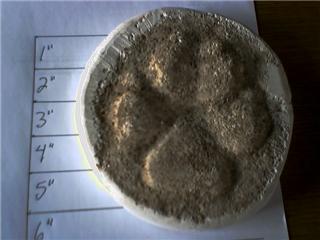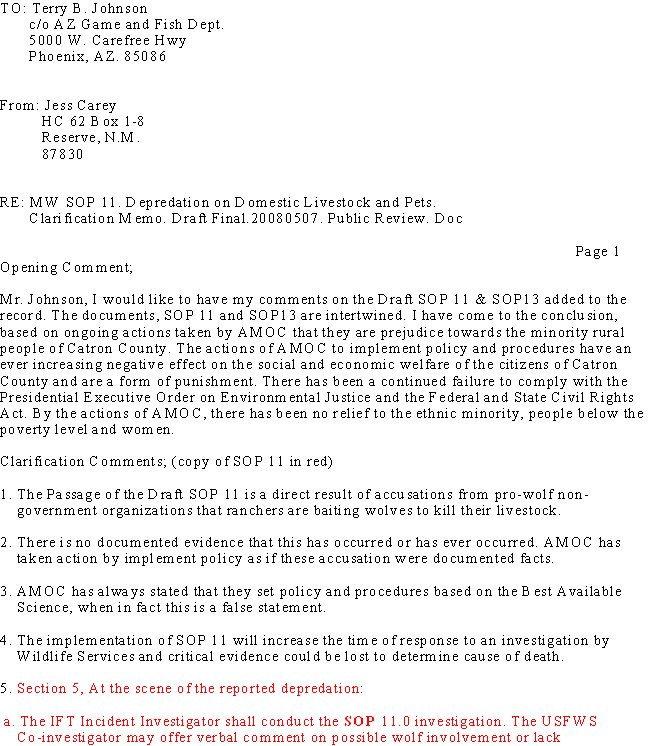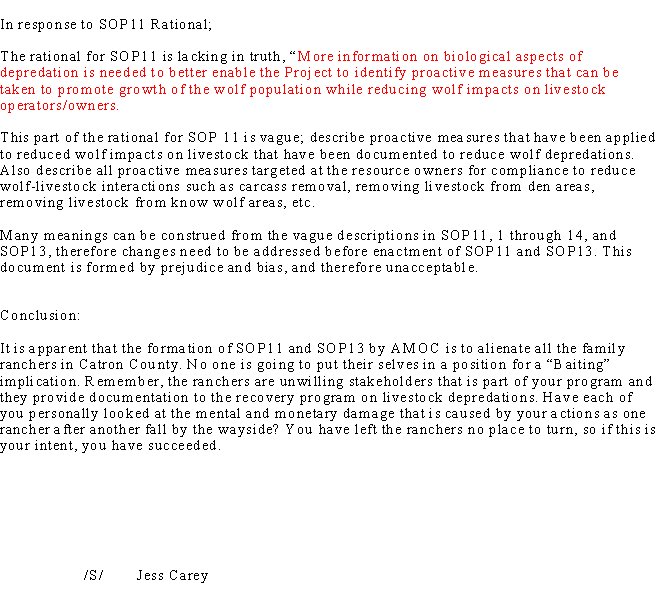The following are excerpts from the Turner Endangered Species Fund website, an NGO, 501(c)3. In case there is any doubt in your mind about this NGO's involvement with wolves and other "endangered" species:
http://tesf.org/turner/tesf/
1997 Highlights include:
releasing eight Mexican wolves into the breeding pens at the Ladder Ranch. Two more wolves will arrive in January 1998. The Ladder facility is one of the largest of its kind in the world and will contribute mightily to Mexican wolf recovery. National Geographic Explorer is documenting the Fund’s involvement with Mexican wolf recovery.
developing a strategy for restoring wolves to Vermejo Park. While biologically feasible, wolf restoration presents tremendous socio-political challenges. To succeed, we must proceed cautiously and be respectful of the needs and concerns of Vermejo’s neighbors.
1998 Highlights include:
continuing our assessment of the suitability of Vermejo Park Ranch as a gray wolf reintroduction site.
continuing efforts to breed and prepare Mexican wolves for release to the wild by the USFWS. During November two females were transported from the Ladder Ranch to a release site in Arizona and during January 1999 a family of two adults and three pups will be taken from the Ladder and released in Arizona. Once this occurs, the Ladder ranch will have contributed seven quality animals to the restoration effort.
continuing our assessment of the suitability of Vermejo Park Ranch as a gray wolf reintroduction site.
1999 Highlights include:
continuing efforts at the Ladder Ranch to breed and prepare Mexican wolves for release to the wild by the USFWS. During spring 1999 a litter of four pups was born at the Ranch. Unfortunately the pups died from natural causes before being weaned.
continuing with development of a plan to integrate Vermejo Park into gray wolf recovery programs. Specifically, we began developing a plan for Vermejo to serve as a gray wolf management “Center of Excellence”. The Center will be designed to improve techniques for recovering gray wolves throughout the United States. For example, captive-born Mexican wolves could be released at Vermejo for purposes of gaining experience in the wild before being permanently released in the Apache National Forest by the USFWS. During their free-ranging period wolves would be able to hone survival skills in an area that supports abundant prey and where human-induced mortality would be virtually non-existent. The Fund proposes to intensively monitor the wolves to document their transition to life in the wild and to ensure quick recaptures if they wander to far afield. No other facility in the world exists to promote the conservation of endangered carnivores in such a unique, hand-on manner.
continuing efforts to promote wolf recovery in the northern Rocky Mountains. Specifically, the Fund proposed assisting the USFWS with developing aversive conditioning techniques to reduce livestock depredations, and monitoring gray wolves that settle the public/private land interface in the northwest portion of the Greater Yellowstone Ecosystem, with an emphasis on the Flying D Ranch. The USFWS reviewed the proposal and intends to authorize the described activities during the next few months. We are now trying to involve other conservation organizations in the effort. Undoubtedly wolves will settle the edge of the Greater Yellowstone Ecosystem, creating great opportunities for organizations like the Turner Endangered Species Fund to advance carnivore conservation in a manner that is respectful of the needs and concerns of local citizens and private landowners.
2000-2001 biannual report includes:
Southern Rockies Wolf (Canis lupus) Restoration
Our central accomplishment for 2000 was catalyzing formation of the Southern Rockies Wolf Restoration Project, a coalition of 17 organizations dedicated to the cause. In 2000, TESF and Defenders of Wildlife sponsored a Southern Rockies wolf restoration workshop. A variety of special interest groups such as the Colorado Cattlemen’s Association attended the workshop, which was facilitated by the International Union for the Conservation of Nature’s Conservation Breeding Specialist Group. The resulting population and habitat viability analysis report greatly advanced the scientific underpinnings of the issue. During the workshop we modeled several landscape variables that influence wolf survival (e.g. road density, distribution and abundance of native ungulates, habitat connectivity) and concluded that the ecoregion could support up to 2,000 wolves.
During 2000 we also finalized a plan for developing a wolf experience center at Vermejo. The Center would improve the survival potential of captive-born Mexican wolves before they are released to the wild. A select number of captive-born, naïve Mexican wolves would be allowed to inhabit the prey-rich Vermejo Park Ranch, accompanied by an extremely intensive research and monitoring program implemented by our field team.
During 2001 we began developing the seminal reference on wolves in the Southern Rockies entitled Suitability of the Southern Rockies for Wolf Restoration: An Ecological and Social Assessment. Additionally, TESF was instrumental in working with Decision Research on a public opinion survey that revealed widespread and bipartisan support for wolf recovery in the region. The Project recently catalyzed the formation of the Southern Rockies Wolf Restoration Information Network. The Network is comprised of the Denver Zoo, Cheyenne Mountain Zoo, Pueblo Zoo, Albuquerque Biological Park, and the International Wolf Center and has a singular mission focusing on education. The Network’s mission is to provide the communities of the Southern Rockies with scientific information about and a diverse public forum for issues related to restoring wolves to the region.
View results of research to assess the suitability of the Southern Rockies ecoregion for gray wolves. View PDF (3.3 MB)
View research to assess suitability of the southwestern United States and northern Mexico for Mexican wolves. View PDF (307 KB)
Mexican wolves (Canis lupus baileyi) – Ladder Ranch, New Mexico
We continued efforts at the Ladder Ranch to breed and prepare Mexican wolves for release to the wild in cooperation with the USFWS. During spring 2000 a litter of pups was born at the ranch. In early 2000, the 6-member Gavilan pack was returned from the wild to the Ladder Ranch facility for management purposes. Throughout most of 2001, a TESF biologist provided routine assistance with the monitoring and management of free-ranging wolves. During 2001 we also served in an advisory and review capacity for the Mexican wolf recovery program. Specifically, we were intimately involved in the technical 3-year review of the reintroduction project being conducted in the Gila and Apache National Forest.
During 2001, the Ladder Ranch Mexican Wolf Pre-release Captive Facility held between 7 and 18 wolves as support for the USFWS Mexican Wolf Recovery Program. One pair was allowed to breed this season, and they produced 3 surviving pups in April. That pack of 9 animals (alpha pair + 4 yearlings + 3 pups) was released in June into the Blue Range Wolf Recovery Area in the Apache National Forest of Arizona.
We conducted 4 transfers of animals between the Ladder Ranch facility and other participating Mexican Wolf Species Survival Program facilities. We created 2 pairs at the Ladder Ranch facility that are scheduled for release into the Gila National Forest of New Mexico in spring 2002. For the first time in many decades, the Ladder Ranch was host to 2 free-ranging Mexican wolves!
2003 Highlights:
maintained captive breeding facilities for black-footed ferrets and Mexican wolves.
continued the desert bighorn sheep restoration project at the Armendaris. (This project is recognized as the most successful efforts of its kind in New Mexico.)
played a key role in prompting the U.S. Fish and Wildlife Service to begin the administrative process for restoring aplomado falcons to the Armendaris and environs.
assisted with monitoring and managing free-ranging gray wolves in southwestern Montana and southwestern New Mexico.
participated in a scientific team which modified the national wolf recovery plan so that the southern Rocky Mountains are properly considered as a restoration region.
2004 Highlights:
maintaining the captive breeding facilities for ferrets and Mexican wolves,
assisting with monitoring and managing free-ranging wolves in southwestern Montana and southwestern New Mexico,
advancing wolf restoration to Vermejo and environs,
http://tesf.org/turner/tesf/reports/
I was unable to copy the 2004 Annual Report. It is worth viewing as you will see documented that the Service (USFWS your taxes at work) gave Melissa Woolf/project a 20% raise. Could she be the same chick that is now taking four years to sail around the world with Andy. Just thought I would ask.
Northern Rocky Mountain gray wolf (Canis lupus)
Wolf recovery is complicated by conflicts with livestock, therefore we are working with ranchers in Montana to reduce these conflicts and are monitoring wolves in southwest Montana to enhance recovery. Our wolf biologist serves as the USFWS wolf biologist for southwestern Montana. (Related site: FWS: Gray Wolf News)
http://tesf.org/turner/tesf/species/
AND,
http://tesf.org/turner/tesf/species/ My favorite page because it has a picture of a wolf next to a chain link fence. Being habituated to humans is part of the problem with released wolves. Also, is a list of collaborators including the ever present Nature Conservancy.
Posts and Comments from Readers
Please include yourself in the discussion. Post a comment.
Saturday, January 5, 2008
Wolves and Ted Turner by Request
Subscribe to:
Post Comments (Atom)



















.jpg)


















No comments:
Post a Comment